Investors flocking to Japanese multifamily property
Overseas investors are flocking to Japanese housing. As the latest deal shows, there is increasing competition within one of the most sought-after real estate markets in Asia-Pacific.

Japanese multifamily residential properties have come onto the radar for overseas investors searching for attractive investments within Asia-Pacific commercial real estate.
Sign in to read on!
Registered users get 2 free articles in 30 days.
Subscribers have full unlimited access to AsianInvestor
Not signed up? New users get 2 free articles per month, plus a 7-day unlimited free trial.
¬ Haymarket Media Limited. All rights reserved.


